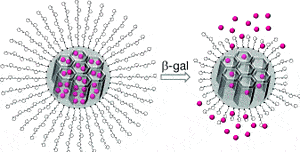A group of researchers have successfully tested a novel nanodevice treatment, in which intelligent nanoparticles selectively open and release drugs which target aging cells. The approach could render results when treating patients suffering from diseases involving tissue or cellular degeneration such as cancer, Alzheimer’s, Parkinson’s, accelerated aging disorders (progeria). It could also boosts results in the cosmetic industry, where anti-aging products are always welcomed.

Intracellular controlled release of molecules within senescent cells was achieved using mesoporous silica nanoparticles (MSNs) capped with a galacto-oligosaccharide (GOS) to contain the cargo molecules (magenta spheres; see scheme). The GOS is a substrate of the senescent biomarker, senescence-associated β-galactosidase (SA-β-gal), and releases the cargo upon entry into SA-β-gal expressing cells.
Senescence is a physiological process of the body to eliminate aged cells or ones with alterations that may compromise their viability. In young, healthy bodies the senescence mechanisms prevents the accumulation of aged cells (senescent) in organs and tissues, which disrupts their proper functions, and sometimes lead to the apparition of tumors. As we continue to age, though, senescent accumulation is inevitable and age related diseases surface. The elimination of these cells would slow down the appearance of diseases associated with aging.
“The nanodevice that we have developed consists of mesoporous nanoparticles with a galactooligosaccharide outer surface that prevents the release of the load and that only selectively opens in degenerative phase cells or senescent cells. The proof of concept demonstrates for the first time that selected chemicals can be released in these cells and not in others,” says Ramón Martínez Máñez, researcher at the IDN Centre — Universitat Politècnica de València and CIBER-BBN member.
The scientists tested the new nanodevice in cell cultures derived of patients with accelerated aging syndrome dyskeratosis congenita. These cell cultures are characterized by a high concentration of senescent cells, due to high levels of beta-galactosidase activity – an enzyme which is associated with senescence. The researchers designed nanoparticles that open when the enzyme is detected release their contents in order to eliminate senescent cells, prevent deterioration or even reactivate for their rejuvenation.
“There are a number of diseases associated with premature aging of tissues, many of which affect very young patients and for whom there is no therapeutic alternative, as in the case of DC or aplastic anemia. Other diseases affect adults, as idiopathic pulmonary fibrosis or liver cirrhosis. These nanoparticles represent a unique opportunity to selectively deliver therapeutic compounds to affected tissues and rescue their viability and functionality” explains Rosario Perona, researcher at the Instituto de Investigaciones Biomédicas (CSIC/UAM) and CIBERER member.
The next step of this research is to test the devise with therapeutic agents and validate it in animal models.
“As far as we know this is the first time that a nanotherapy for senescent cells has been described. Although there is still far to go from these results to the possible elimination of senescent cells or rejuvenation therapies, we believe that our research may open new paths for developing therapies for the treatment of age-related diseases,” says Ramón Martínez Máñez.
Findings were published in the journal Angewandte Chemie International.









